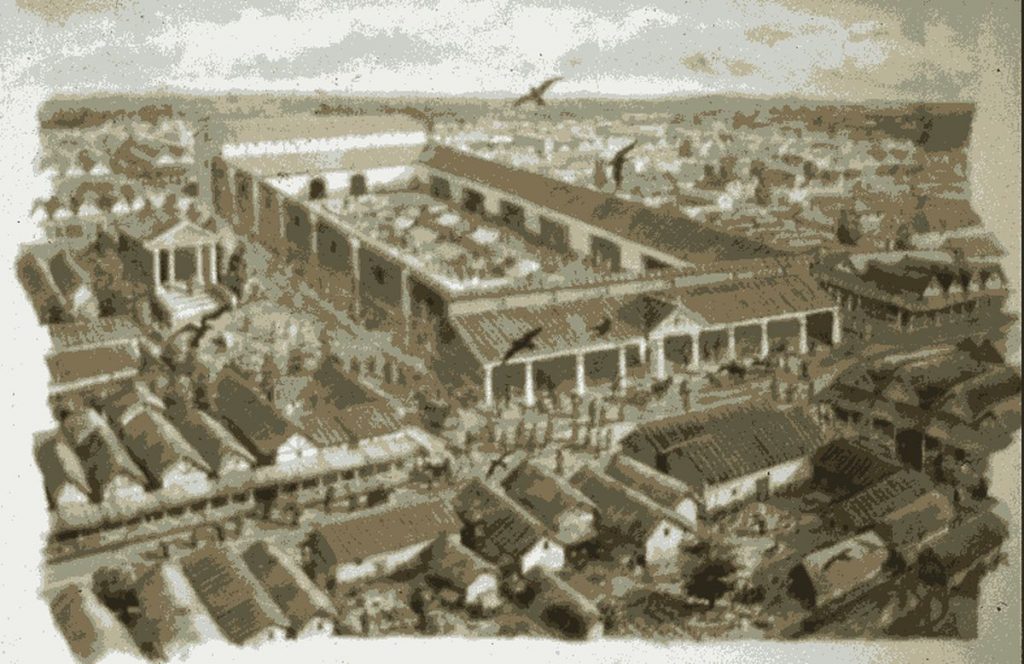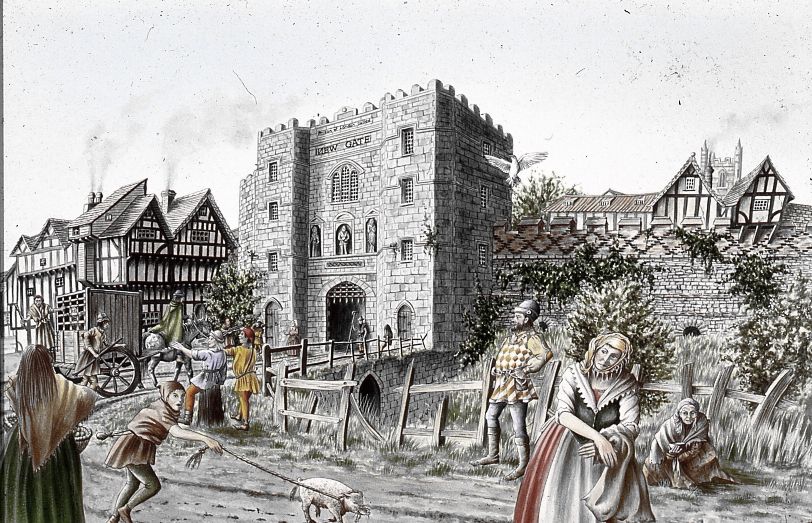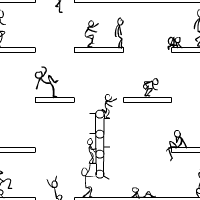To book click here
Myths, Legends And The Origins Of London Virtual Walk
Sunday 3rd January 2021 6.30pm
The walk is led by Kevin Flude, a former archaeologist at the Museum of London, who has an interest both in the archaeological evidence as well as the myths and legends of London’s origin.
The walk will tell the story of the legendary origins of London which record that it was founded in the Bronze Age by an exiled Trojan called Brutus. The new City was called Troia Nova or New Troy, which became corrupted to Trinovantum, and then changed to Lud’s Dun and eventually Londinium. The legends provide a host of characters in the rich mythic past of London. Kevin will tell the stories, and relate some to the archaeological evidence.
The route starts at Tower Hill, then down to the River Thames at Billingsgate, London Bridge, up to the Roman Forum at the top of Cornhill, into the valley of the River Walbrook, passed the Temple of Mithras, along Cheapside to the Roman Amphitheatre, and finishing up in the shadow of St Pauls.
This is a London Walks Guided Walks. Look at their web site for a list of other of their amazing walks.
To buy tickets click here:
Flower Of Cities All – Medieval London History & Archaeology Virtual Walk.
Sunday 22nd November 2020
The walk is led by Kevin Flude, a former archaeologist at the Museum of London, a Museum Curator and University Lecturer.
A walk which explores London in the Middle Ages, from 1066 to the end of the 15th Century. In 1066 London was not yet the formal capital but as London expanded it took over from Winchester. By 1400 London was dominating the affairs of the Kingdom in spectacular fashion and had grown into a sophisticated medieval Capital. The Walk takes us from Westminster to Bishopsgate. and to the site of one of the few remaining medieval Churches at St Helens. We follow the route of the 15th Century London Lickpenny poem and look at everyday life in the City in the main markets streets of Cornhill, Poultry, Bucklersbury and Cheapside. We also visit the Guildhall and the City Wall. We will walk in the footsteps of Geoffrey Chaucer, in the muddy City Streets, exploring the unhealthy conditions and poverty amidst great riches and pageantry. We will see where the Italians, the German, the Dutch, the Jews, and the French lived cheek by jowl with native Londoners and immigrants from the Midlands.
This is a London Walks event. Look at their web site (www.walks.com) for a list of other of their amazing walks.
TO BUY TICKETS CLICK HERE:
Here is a short podcast to go with the walk.
This is a London Walks event by Kevin Flude
The Decline and Fall of Dark Age London Archaeology Virtual Walk
Sunday 1st November 2020
The first British Brexit? The Roman Britains kicked out the Romans in 407AD, and then asked them to come back after a catastrophic collapse. Faced with plaque, civil war, invasion, mass immigration, industrial decline, reversion to barter the authorities struggled against anarchy and the Dark Ages.
Or was it? Wasn’t it a rather a transition into the Late Antique period in which life for most people went on much as before except paying taxes to local rulers not to distant Romans?
This virtual walk explores why the Roman system in London broke down, and what really was the impact of the end of the Roman system in London.? What is the evidence? Can we do much more than guess? How should we regard the written records? We tramp the virtual streets of London in search of the light to shine on the Dark Ages.
This is a London Walks event by Kevin Flude.
To Book for this walk click here
Also given as a physical walk at 2.30 pm on Saturday, September 28, 2019. The meeting point was exit 2 St. Paul’sTube.
New Series of Archaeological Virtual Walks for London Walks

This is my schedule of Virtual Walks. One every Sunday at 6pm.
The Programme is:
Sunday 25th October 2020 The Archaeology and Culture of Roman London Virtual Walk. For more details click here. To buy Tickets click here:
Sunday 1st November 2020 The Decline and Fall of Dark Age London Archaeology Virtual Walk. For more details click here. To buy Tickets click here:
Sunday 8th November 2020 The Rebirth of Saxon London Archaeology Virtual Walk For more details click here. To buy Tickets click here:
Sunday 22nd November 2020 Flower of Cities All – Medieval London History & Archaeology Virtual Walk For more details click here. To buy Tickets click here:
Sunday 29th November 2020. The London of Thomas More and Thomas Cromwell Virtual Walk For more details click here. To buy Tickets click here:
Sunday 6th December 2020 The Financial City from Slavery to Hedge Fund Virtual Walk For more details click here. To buy Tickets click here:
Sunday 13 th December 2020 Myths, Legends and the Origins of London Archaeology Virtual Walk . For more details of this walk click here. To buy Tickets click here:
Bookings will be via Eventbrite and London Walks and links will be posted here.
Manifesto for free access to digital archives
The Passenger Pigeon Manifesto is a call for cultural institutions to open their digital archives for free use by the public. You can see the manifesto in the link below.
It would mean a loss of income from copyright for organisations who are already short of money but on the other hand it would help greatly increase access to our cultural heritage, and, it would help preserve these items, at least digitally, into the long distance future.
So, to my mind, a good thing. I’m trying to find out how to sign up.
Please note it is not asking for low quality reproduction but the high definition copies.
MYTHS, LEGENDS AND THE ARCHAEOLOGICAL ORIGINS OF LONDON
Virtual Guided Walk for London Walks
Currently, not programmed.
This virtual walk is led by Kevin Flude, a former archaeologist at the Museum of London, who has an interest both in the archaeological evidence as well as the myths and legends of London’s origin.
A Walk for London Walks.
Archaeology in the late 20th and early 21st Centuries has revolutionised our view of the early history of London while its rich set of myths and legends have been largely forgotten. This walk is designed to set that right and give an insight into London’s legends, and how they relate to modern archaeological discoveries.
According to legend London was founded in the Bronze Age by an exiled Trojan called Brutus. He called the new City Troia Nova or New Troy, which became corrupted to Trinovantum. Around the time of Julius Caesar the name changed to Lud’s Dun and eventually to Londinium. Early archaeologists therefore looked for a prehistoric City, to add to the history they could read by classical authors of a City founded shortly after the Roman Invasion of 43 AD. When the Roman system broke down in 410 AD, historical and archaeological records become almost non-existent, until the foundation of St Pauls Cathedral in 604 AD. The two hundred year gap, sometimes called the Dark Ages, has another rich selection of legends. The walk will explore these stories and compare to the archaeology.
The route starts at Tower Hill, then down to the River at Billingsgate, along the River to London Bridge, up to the Roman Forum at the top of Cornhill, into the valley of the River Walbrook, passed the Temple of Mithras, along Cheapside to the Roman Amphitheatre, and finishing up in the shadow of St Pauls.
This is a London Walks Guided Walks. Look at their web site for a list of more of their amazing walks
Virtual Tour – British Library
An email from the British Library exhorting me to:

So I did. And what did I find?
A dullish page, but with hopefully many delights hidden in the links.
I began with an exploration of the architecture, which was just a bit of text with a few images. And, much to my delight a whopping typo when referring to the wrong Gilbert Scott as inspiration to the architect, Colin St John Wilson. 4 out of 10, I fear.
I then took a safe bet to look at the Virtual Books. I have long admired the ability to look through the books in the Treasures Gallery in digital form – mostly looking at the Lindisfarne Gospel, Leonardo Da Vinca, and Alice. So, I clicked the link, to another surprisingly dull page with only 6 books to excite. But I knew there must be more, and to the top right was a link to ‘View All‘. Clicking this revealed some of the wonders of the world of books; from a Ethiopian Bible, to Lewis Carroll’s handwritten Alice’s Adventures Underground to works by Jane Austen. Each one in blazing colour and which the visitor can zoom in on and thumb through.
Beautiful and I chose a Psalter that is annotated by Henry VIII’s himself. Wow!

Why, I wonder, do the British Library make so little of it? I only got to it as i knew that had it. Most would pass by.
This gets a 10 out of 10 for awe-inspiring content, and a 3 for hiding its light under a bushel.
Next, I was excited to see a exhortation to ‘Visit an Online Exhibition.‘ This was what I had come here for. Really, excited. When I got there, there were 44! I was really looking forward to this.
But they were not exhibitions, they were a series of articles and blog posts. All very interesting, and all illustrated with lots of images of beautiful objects. But in no-way an online exhibition.
So very disappointed.
Overall, the British Library web site has some absolutely marvellous stuff. But its not really digital, its just online. There is no feeling of a digital experience, digital content yes, a digital experience. no.
It should be a 10 out of 10, and it is for content but for a digital experience, I’m hard pressed to give it a 6.
Link to the Old Blog
Going Live
Its now Monday and I can see that this is addictive or rather obsessive. I could spend all my time improving, developing, converting, tinkering. Remaking myself in my own image.
But then I would get no work done?


